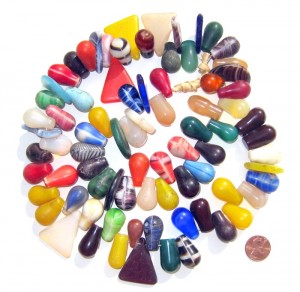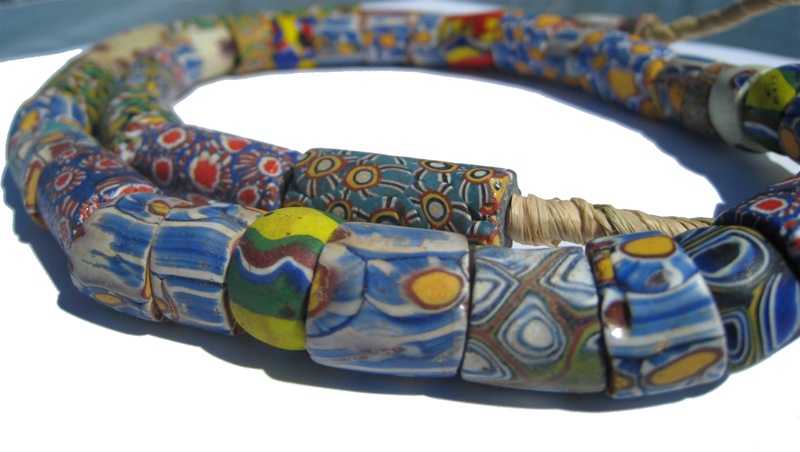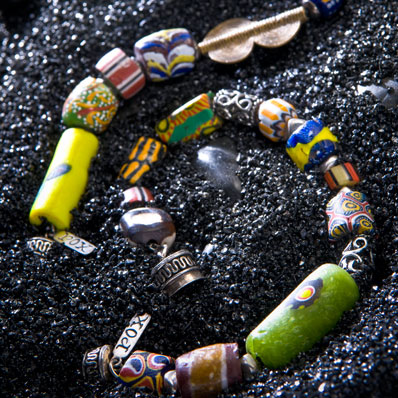A Buyers Guide To Mali Trade Beads – What To Look For, What To Avoid
Speckled, marbled, bulbous or triangular. Regardless of their shape, color, size or opalescence, there's no denying that Mali Wedding Beads are some of the most spectacular of African origin. From the simple way they refract and reflect light, to the way they hang when strung as a 'bouquet' for a focal necklace center-piece, Mali Wedding Beads exude a beauty and mystique that often belies their archaic history.
With the surge in popularity of auction sites as a primary means of retail, there has also been a ten-fold increase in the quantity of African beads being sold through these mediums. Mali Wedding Beads, along with Venetian Trade Beads, and African Chevrons comprise some of the most sought-after African bead variants, yet shopping for the 'real deal' has become a lot more challenging.
Why is it so difficult to source genuine Mali Beads?
The primary factor that has led to many questioning the authenticity of Mali Beads (that are not sold through accredited wholesalers and dealers), is the production of replicas and reproductions by both Middle Eastern and Western entities. Mali Wedding Beads can often command quite high prices, particularly if sufficient evidence accompanies them to prove they are of pre-1900 origin, and modern techniques are such, that it can be almost impossible to distinguish a reproduction from a true authentic bead.
Signs of Authenticity
If you've been an avid collector of African trade beads for a while, you will more than likely be familiar with the quality, weight and appearance of such old beads. African trade beads tend to have survived over a Century of exchange, travel, wear and tear to end up with the supplier selling them onto you. As a result, their general appearance, texture, and even structure may have suffered from such long life - characteristics loved by the people that collect them, and often what influences their high value in some cases. Other things to look for, or beware of include:
- Obvious Seams: It's generally very rare to come across Mali Wedding Beads that bear a pronounced or obvious seam. Part of their allure is the inherently smooth, glossy finish. If the Mali Beads you're looking at appear to have a prominent ridge from the bulb to the tip, chances are it is a modern reproduction.
- Threading Holes: Sounds daft doesn't it. Surely any bead should bear a threading hole, given their primary purpose is decorative. You'd be surprised at just how many 'replicas' are sold on a daily basis that do not feature this trademark Mali Bead characteristic! Old Mali Beads always bear a vertical threading hole at the 'head' of the bead (the part narrower than the bulb.) Modern variants are produced with a metal pendant fish-eye attachment or something similar, so that the bead can be used as a single pendant.
- Quantity: Authentic African trade beads are always sold by the string upon which they were sourced, by wholesalers committed to protecting the quality and authenticity of such beads. Such beads are often discovered in this state, and will have remained like this since they were first strung a hundred or so years ago. Sellers who break down African trade beads are usually those selling them on auction sites, out to make a quick profit with little regard for the authenticity, and historic relevance of keeping beads together.
- Number in Stock: Authentic trade bead retailers will usually be happy to inform you of the likelihood of certain beads coming back into stock, as well as their sources of stock. An extremely high number of 'bead strings' being sold through an independent dealer (particularly through marketplaces or auction sites) is indicative that they may not be genuine. Accredited dealers rarely have surplus. In fact, they tend to sell out of their authentic wares within days of it's arrival. Due to sourcing direct from Africa, it may also be a wait before such stock reappears upon their store catalog.
Other than the above, you should expect real Mali Wedding Beads to feature signs of wear and age. They may appear dirty, pitted, scratched, worn and even sun-bleached in some cases - all characteristics that indicate age, wear and extensive travel from one person to another. When your Mali Beads arrive, don't be disappointed to find them in such condition - it's part and parcel of their history, genuine character, and most importantly authenticity!
Venetian Millefiori “Thousand Flower” Trade Beads
My favorite trade beads are Millefiori trade beads from Africa. Millefiori is a word which literally means "thousand flowers". Millefiori beads are handcrafted beads that have flower designs layered into them. Because they are handmade, each bead is unique. There are no two beads alike.
These beads can run you anywhere from $8 - $60 a piece. They are cherished for their history and age. To many, they are known as "African Trade Beads." Most Millefiori trade beads have traveled multiple contents, including Europe, Africa, and the United States. You can also purchase them by the strand, in which case they run between $80 and $500.
As you can see in the photo above, they are colorful and crafted with such great detail. Each bead is a work of art that should be cherished to the fullest. Millefiori trade beads make great centerpieces for necklaces and jewelry. True, they are quite an investment, but I guarantee, it is well worth it. You can have a lot of fun with these great beads!
Top 5 Reasons Why I Love Using Trade Beads in my Jewelry
Many of my fellow jewelers and craftsmen/women often ask about my obsession with trade beads. I use them in nearly every piece of jewelry I create, so it leads many to wonder, what is the significance of trade beads? Why use trade beads? Well, here are my top reasons for using trade beads in my jewelery.
-
Trade Beads are handmade, and made with love.
Unlike most of the beads in the market today, primarily dominated by Indian and Chinese beads, trade beads are each made by hand, with love, the old fashioned way. It feels nice knowing you are wearing something that was not made by a machine or robot, but rather, by a fellow human 🙂
-
Each bead is one of a kind.
Because trade beads are handmade, every single bead is unique and one of a kind. There are no two beads that are exactly the same! This is particularly noticeable when shopping for Millefiori beads and Venetian trade beads.
-
Wearing trade beads is like wearing a piece of history.
Trade beads date back as some of the oldest beads in modern history. Most trade beads have traveled at least three continents, and have been possessed by multiple owners, especially old trade beads. There's nothing like wearing a piece of history!
-
Shopping for trade beads is fun!
Shopping for trade beads is unlike shopping for most of other types of beads. Because every bead is handmade and one of a kind, shopping never gets old. You never see the same thing twice.
-
Trade beads are usually part of the fair trade.
Most trade beads are considered "fair trade beads", meaning the craftsmen, craftswomen, and artisans involved in creating the beads were not exploited in the process of bringing these beads to you. They are paid the amount they deserve. You know that when you purchase fair trade beads, you are helping to improve the lives of the people who made these beads for you.
Of course, these are only five of the many reasons why I love to use trade beads when creating jewelry. Their significance is unprecedented, and they are the most cultured of beads.
Why do you use trade beads in your jewelry? Post a comment below and share!


